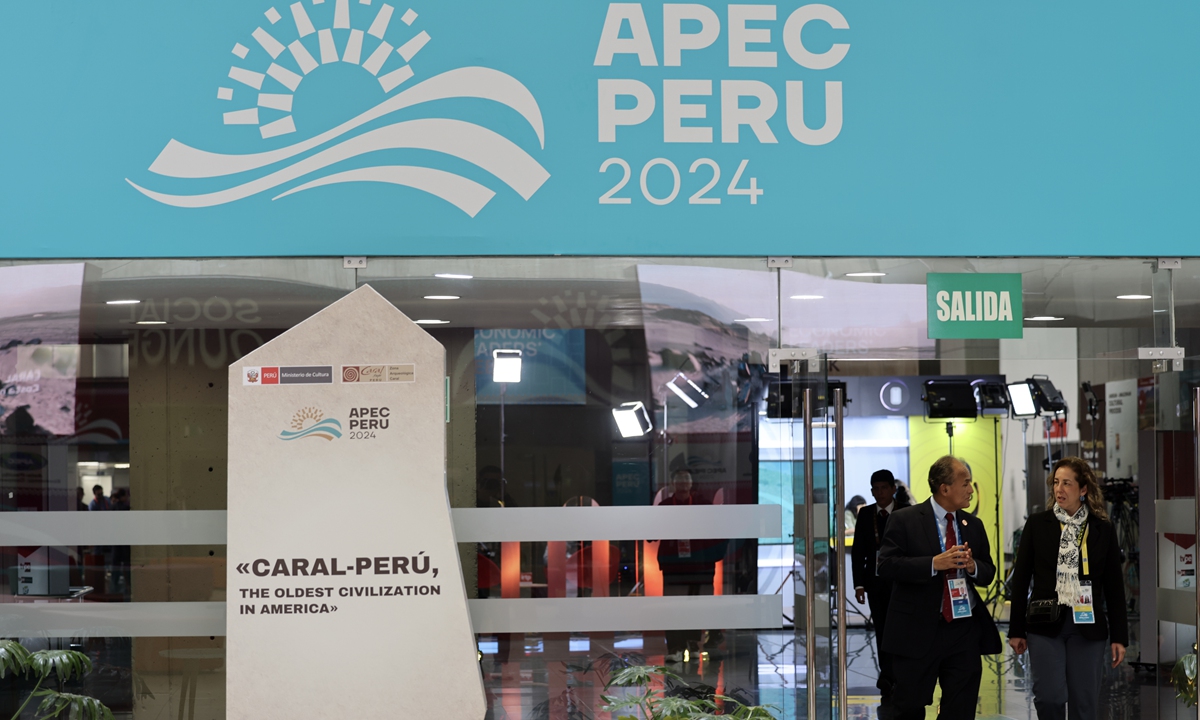
A view of the International Media Center for the 31st APEC Economic Leaders' Meeting in Lima, Peru. Photo: cnsphoto
Editor's Note:
The 31st APEC Economic Leaders' Meeting in Lima, Peru, concluded on Saturday, with leaders of 21 member economies calling for enhanced free trade and greater connectivity. Facing unprecedented global risks and challenges that cannot be addressed by any single economy alone, Asia-Pacific economies are expected to engage in closer cooperation to withstand turbulence and build a community with a shared future for mankind. In an interview with Global Times (GT) reporter Qian Jiayin, Cynthia Sanborn (Sanborn), director of the Center for China and Asia-Pacific at Universidad del Pacífico in Peru, said that APEC serves as a useful platform for developing business contacts and opening new opportunities for trade.
GT: The theme of this year's APEC meeting is "Empower, Include, Grow." Why do you think this theme was chosen for the APEC meeting in Peru? How has the APEC mechanism contributed to the development of Latin American countries?
Sanborn: I think that the primary objective is to "overcome existing differences among the group" of member economies - including the US, China, Russia, among others - aimed at bridging existing differences. This collaborative effort seeks to establish a roadmap toward an integrated global economy.
Inclusion holds particular significance in this theme, as organizers are committed to fostering active engagement from sectors within these societies that have traditionally been marginalized in national and global forums. These sectors include women, Indigenous communities and young people.
In evaluating the developmental impact of this forum, it is important to note that only three Latin American countries - Peru, Chile and Mexico - are members of APEC. As small open economies and major commodity exporters, Peru and Chile have benefitted enormously from their early participation in diverse international forums dedicated to free trade and globalization. Their opening to Asian markets and trade has significantly contributed to their economic growth and development.
Today, China stands as the largest trading partner for both Peru and Chile, underscoring the significance of these ties. Peru, for instance, has established trade agreements with 14 of the 21 APEC member economies. Furthermore, participation in APEC has facilitated the involvement of Latin American countries in the Comprehensive and Progressive Agreement for Trans-Pacific Partnership, reinforcing their commitment to regional integration and trade expansion.
In addition, APEC serves as a useful platform for developing business contacts and opening new opportunities for trade.
GT: The Chinese-invested and built Chancay Port was opened on November 14, marking another iconic project under the Belt and Road Initiative (BRI) in Latin America. What are your views on the future prospects of Chinese investment in Peru and Latin America?
Sanborn: It is important to emphasize the significant potential and interest within Latin America for expanding Chinese investment, particularly in high value-added sectors that can drive sustainable development. While certain countries, like Brazil, are not formal participants in the BRI, they nonetheless attract substantial Chinese investment in critical areas such as renewable energy and electric vehicle production, underscoring the strategic importance of these partnerships. Peru, with the development of the Chancay Port, also stands ready to be a logistic and maritime trading hub, connecting all of South America with Asia, as well as creating a special economic zone in which such value-added industries can be developed.

Cynthia Sanborn Photo: Courtesy of Sanborn
GT: APEC has long worked to eliminate trade barriers in the Asia-Pacific region. However, given the rise of protectionism and the severe challenges facing the multilateral trading system, how do you think the APEC multilateral framework should respond to these challenges?
Sanborn: The rise of protectionism is a pressing concern for countries in Latin America. We have free trade agreements with over half of APEC members, including key partners such as the US and China. We remain hopeful that these agreements will be respected across political transitions, preserving the mutual economic benefits they provide. In this context, forums like APEC are crucial for keeping the discussion of fair and open trade on the table, serving as vital platforms to advocate for a rules-based multilateral trading system.
GT: In recent years, China's cooperation with Latin American and Caribbean countries has become increasingly broad and deep. However, the US has not abandoned its "Monroe Doctrine," attempting to undermine China's influence in the region. What impact do you think this has had on the development of Latin America and China-Latin America economic and trade relations?
Sanborn: The Monroe Doctrine originally aimed to deter European colonial ambitions in the Western Hemisphere, asserting that any intervention in the political affairs of American nations would be viewed as a potentially hostile act toward the US.
This was a guiding principle in US foreign policy well into the 20th century, however, it is no longer formally in force today. And Latin America would not tolerate the resumption of the Monroe Doctrine by the next US administration, as we are mature nations free to engage with the rest of the world in ways that best serve our national interests. The notion of the US exercising exclusive control or hegemony over this region is an outdated concept, incompatible with the realities of the 21st century.
So far, US attempts to limit Latin American relations with China have been largely rhetorical. Our primary exports to China, including minerals and agricultural products, remain essential to our economies, and we expect to continue this trade while also diversifying our partnerships with China, the US and other countries.
GT: With APEC and G20 being held in Latin American countries, issues like the rise of the Global South and global governance have again become key topics of focus for participants. What does the rise of the Global South in global governance mean?
Sanborn: The evolving role of the Global South in global governance has become an important topic of discussion, with Latin American leaders having contributed to the demands of developing countries for a redefinition of global institutions and for greater attention to issues such as climate change, inequality, and social and environmental justice. Yet, it is also clear that the countries commonly grouped under the "Global South," including those in Latin America, do not form a monolithic bloc and often differ in their perspectives and policies.
On global issues like the crises in Gaza and Ukraine, Latin American countries hold a range of views, reflecting the region's diverse political landscapes and priorities. Navigating the path toward transformative change in global governance while respecting the varied standpoints and complex realities of these nations remains an ongoing challenge.





